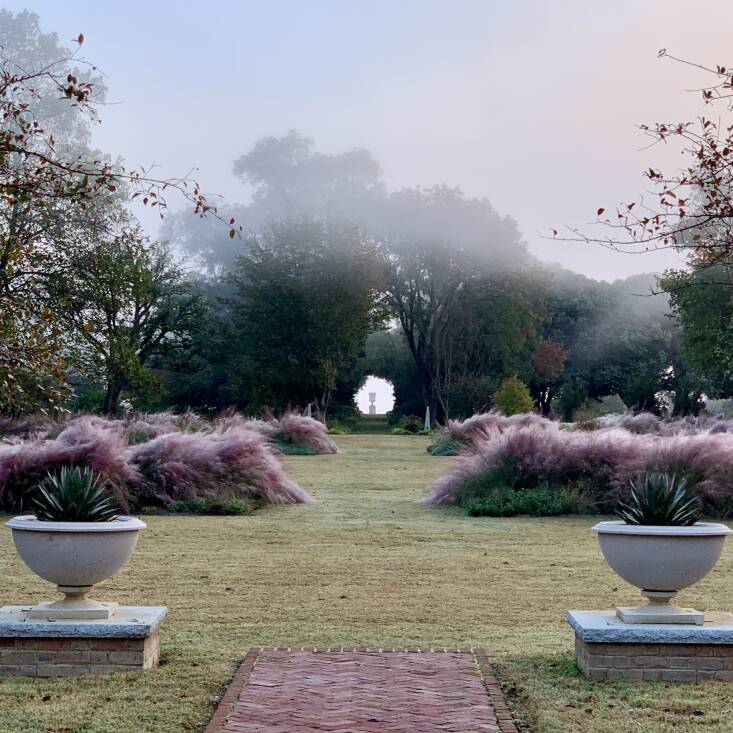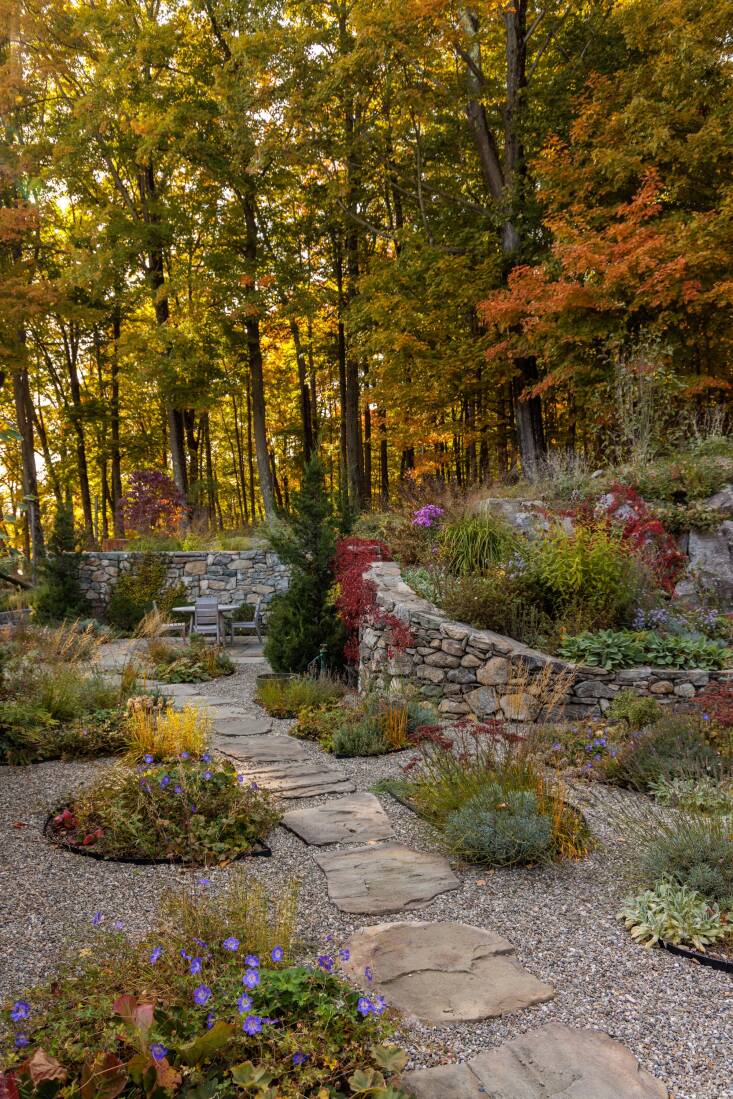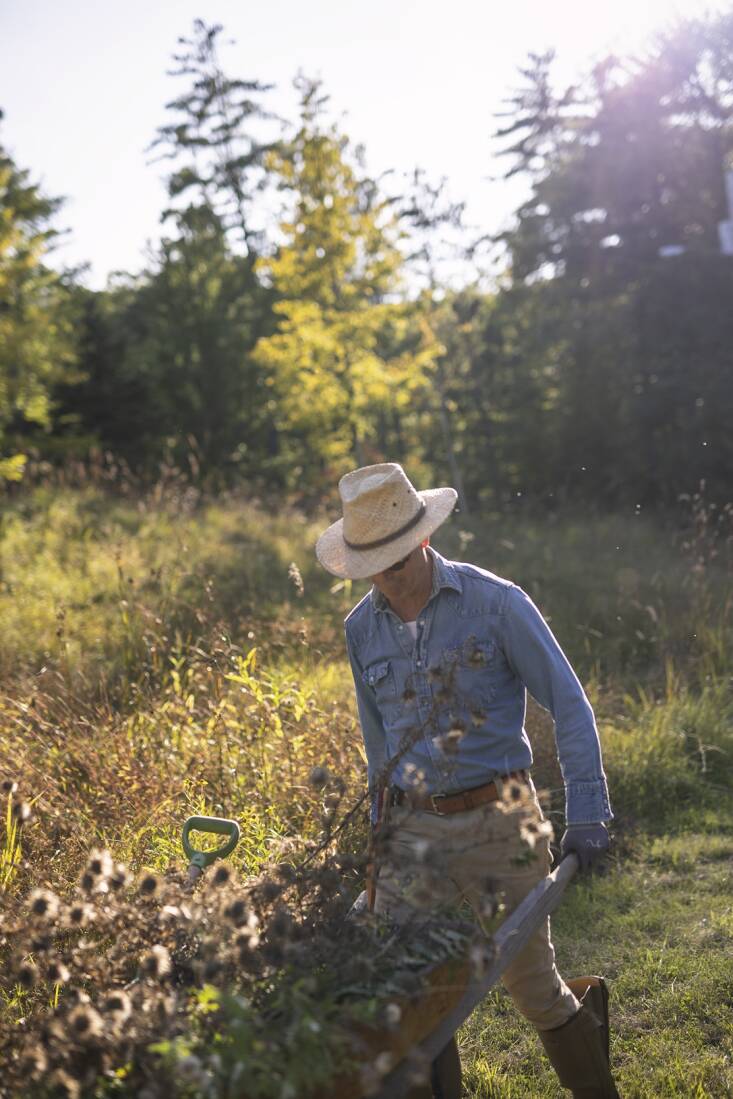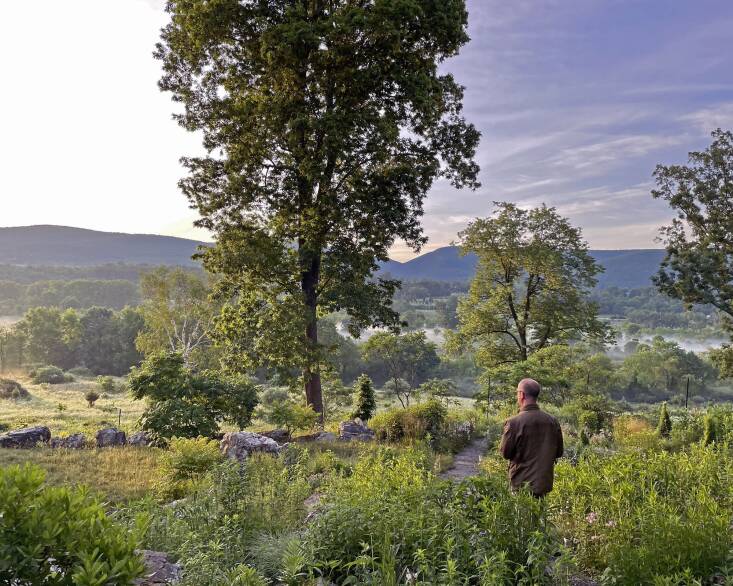What’s in a name? In the case of landscape design firm Hortulus Animae, it’s the key to what motivates its founder Jean-Marc Flack. Hortulus Animae means “Little Garden of the Soul” and was originally the title of a book of prayers printed in the late 1400s. And fittingly, the projects he designs are soulful—expansive and intimate at once, brimming with biodiversity, and profoundly beautiful. His landscapes stir the spirit.
Before starting his award-winning practice in the Hudson Valley in 2014, Jean-Marc spent more than two decades as a fashion-industry executive. “That background, along with formal studies in philosophy, psychology, and sustainable garden design at the New York Botanical Garden, continues to inform my practice—uniting art, culture, and ecology through a deeply personal lens,” he tells us.
“I approach landscape design as both an artistic and ecological practice—a dialogue between creativity, craft, and the living systems of a site,” he continues. “My work explores how beauty, color, line, and form can exist in conversation with horticulture, ecology, and botany to create gardens that are both expressive and alive. Each project begins with the story of a place—its architecture, topography, and ecology—and becomes a site-specific response to the client’s vision and the land’s inherent character.”
Read on to learn what moves him as a plantsman and designer—and what repels him.
Photography courtesy of Jean-Marc Flack.
Above: Jean-Marc is currently breaking ground on a new project in the Berkshires, “a landscape that will include a natural swimming pool (in collaboration with Anthony Archer-Wills), a ruin garden, an orchard, and a wetland nature trail,” he tells us.
Your first garden memory:
As a child, I spent summers visiting my Tante Germaine’s country garden and potager in Belley, in the Auvergne–Rhône–Alpes region near Geneva. For a city kid, it was an enchanted world—my first encounter with a life shaped by plants. I didn’t yet know their names, but I was spellbound by the sensory world they created: the heady fragrance of Buddleja in the hedgerow, the rubbery squeaky foliage of Bergenia cordifolia lining the drive, the tart burst of translucent, bright red Groseille currants and the jellies they became, the crunch of pea gravel underfoot, and the cluttered greenhouse with its empty pots and tools. It was a place of pure mystery and wonder that I can still smell today.
Garden-related book you return to time and again:
On a day to day, the Manual of Woody Landscape Plants by Michael A. Dirr is an indispensable reference guide when choosing specific woody plants and cultivars. On a more philosophical level, I am extremely inspired by Gilles Clément, the French garden designer who wrote The Planetary Garden and coined such powerful concepts as the “Garden in Motion,” the “Planetary Garden,” and the “Tertiary Landscape” that have informed my approach to landscape design. I feel it is crucial for us now to rethink our relationship to the land and celebrate biodiversity, plant agency, and connectivity as directives to design landscapes that minimize disturbance and support wildlife.
Instagram account that inspires you:
@Roy_diblik_—a consummate native plantsman, designer, and ecologist, and constant source of inspiration.
Describe in three words your garden aesthetic.
 Above: “A big part of our role as designers is helping clients rethink outdated notions of what a “beautiful” landscape looks like—showing that biodiversity and elegance are not mutually exclusive, but can be deeply intertwined.”
Above: “A big part of our role as designers is helping clients rethink outdated notions of what a “beautiful” landscape looks like—showing that biodiversity and elegance are not mutually exclusive, but can be deeply intertwined.”
Mindfully controlled chaos.
Plant that makes you swoon:
I’m captivated by Calycanthus ‘Aphrodite,’ or sweetshrub—it’s a true sensory delight. Its deep red, magnolia-like flowers, showy but never garish, bloom from late spring into early summer. Every part of the plant is fragrant: the blooms smell uncannily of strawberries, while the bark, leaves, and seed pods release a spicy scent when crushed. A hybrid by Dr. Tom Ranney of the University of North Carolina, it combines eastern and western sweetshrub species and still teems with pollinator life—from butterflies to beetles.
Plant that makes you want to run the other way:
I try not to be dogmatic about plants, but a few still make me wince. Forsythia’s blinding yellow—often paired with equally brash Narcissi—feels more assault than spring awakening. And burning bush (Euonymus alatus), with its invasive habit and electric-red fall color, isn’t far behind. There’s enough true drama in nature without the neon.
Favorite go-to plant:
 Above: A lush Clematis virginiana vine framing a yellow door.
Above: A lush Clematis virginiana vine framing a yellow door.
Picking a single plant feels impossible for a true plant lover—each garden has its own character—but I try to include Clematis virginiana, or Virgin’s Bower, somewhere on every property. This vigorous native vine (not to be confused with invasive C. ternifolia) drapes beautifully over fences and garden structures, with clouds of midsummer bloom, silky seed heads that last into winter, and constant pollinator activity.
Hardest gardening lesson you’ve learned:
These days the hardest lesson is how unpredictable the climate has become. You can study a site, pick the right natives, and still watch weather extremes undo your best work—especially with young trees and shrubs. The takeaway? Water more than you think, and do it slowly, letting moisture reach deep into the soil where roots can truly establish.
Unpopular gardening opinion:
Believe it or not, standing firm on not using chemical herbicides at all (no Glyphosate!) has gotten me into difficult conversations with other professional landscape designers who insist that it is actually acceptable and even recommended to clear existing vegetation when preparing larger scale sites for new plantings. I will always opt for mechanical solutions and regular manual weeding, even if it is more time consuming and costly.
Gardening or design trend that needs to go:
 Above: “Finding the right balance between planting, lawn, and structure is key to creating a legible, functional, and ecologically sound landscape. I’m particularly interested in how wild, naturalistic plantings can work in concert with formal, structured elements—stone walls, paths, and terraces—to create a harmonious contrast that amplifies, or restores, the landscape’s inherent vitality.”
Above: “Finding the right balance between planting, lawn, and structure is key to creating a legible, functional, and ecologically sound landscape. I’m particularly interested in how wild, naturalistic plantings can work in concert with formal, structured elements—stone walls, paths, and terraces—to create a harmonious contrast that amplifies, or restores, the landscape’s inherent vitality.”
Heavy-handed hardscapes and “hair-plug” plantings. Thoughtful hardscaping is important—it frames wilder plantings, creates outdoor rooms, and adds legibility—but the goal should always be balance with the lightest possible touch. I prefer local stone and dry-set techniques to keep things permeable and soft. What I can’t get behind are those rigid, linear plantings—the neat rows of Calamagrostis x acutiflora ‘Karl Foerster’—too sterile. I’ll always choose layered, diverse plantings that move and mingle as nature intended.
Old wives’ tale gardening trick that actually works:
Beer traps for slugs work! My Tante Germaine had a huge slug problem in her French country garden, so I saw these in action at an early age. While I am always loath to kill any living creatures, and only use traps as a last resort, I did use these in my first home garden in Carmel, NY, with great success.
Favorite gardening hack:
Use your excess fallen leaves from lawn areas to make your own mulch by shredding and composting on site. But do leave the leaves in plant beds and wooded areas as mulch and habitat over winter.
Favorite way to bring the outdoors in.
I’m always looking for ways to blur the boundary between indoor and outdoor life. That might mean tucking planting beds into a masonry terrace, framing views with layers of vegetation, or designing garden paths that beckon you—or even just your gaze—into the garden. I often try to blur the transition between garden and broader landscape to create a more immersive view from the residence.
Every garden needs a…
Dry-set stone sitting wall to delineate and frame spaces and add structure and thresholds to more wild and playful plantings
Favorite hardscaping material:
 Above: Reclaimed hardscaping was used for this courtyard garden. Photograph by Alon Koppel.
Above: Reclaimed hardscaping was used for this courtyard garden. Photograph by Alon Koppel.
Local stone, always—and whenever possible, reclaimed or salvaged material from the site itself. There’s something deeply satisfying about giving old pavers, wall stone, or boulders new life in the same landscape. This helps anchor the garden in its own history and keeps the hardscape feeling as though it’s grown right out of the place.
Tool you can’t live without:
The single most useful and versatile tool a gardener can own is a hori hori—a Japanese gardening knife-trowel hybrid. My favorite is the classic Niwaki version; I keep one in its holster at all times for weeding, planting, cutting, or setting bulbs and plugs. We train all our teams to use it—it’s amazing how much confidence and precision it brings to the work.
Go-to gardening outfit:
 Above: Jean-Marc in his gardening uniform. Photograph by Martin Crook for Upstate Diary.
Above: Jean-Marc in his gardening uniform. Photograph by Martin Crook for Upstate Diary.
My goal in dressing for a day in the field is always to balance function and comfort. I want to be fully covered—protected from sun and ticks—but still able to move easily. My basic uniform: a vintage Wrangler denim shirt, L.L. Bean chinos, a wide-brim Panama straw hat, Niwaki gloves, and my Le Chameau wellies—especially when the ground turns to mud.
Favorite nursery, plant shop, or seed company:
Catskill Native Nursery in Kerhonkson is a gem. Francis and Diane are deeply knowledgeable and endlessly enthusiastic about plants, and their passion is infectious. I always discover something new there—or find native species that aren’t usually available in cultivation. I can never visit without leaving with a few new treasures.
On your wishlist:
Natural swimming pool. I’ve had the opportunity to design them for clients, including one currently under construction, and I’d love to have one of my own someday. I love aquatic plants—the way they move, filter, and create whole little ecosystems feels magical to me.
Not-to-be-missed public garden/park/botanical garden:
Innisfree in Millford, NY: This 185-acre landscape creates a sublime composition of rock, water, plants and sky. Among my personal favorite features are the Ruin Garden and Lakeside Point Landing.
The REAL reason you garden:
 Above: Jean-Marc visiting a project in Copake, NY.
Above: Jean-Marc visiting a project in Copake, NY.
I simply can’t help myself! Gardening is a bit of an addiction that doubles as meditation and a therapeutic outlet for stress. There’s nothing more satisfying than planting—or more calming than a good weeding session. I can get lost, literally and figuratively, while working in the garden; everything else just melts away.
Thank you, Jean-Marc! (You can follow him on Instagram @hortulus.animae.)
For our full archive of Quick Takes, head here.



